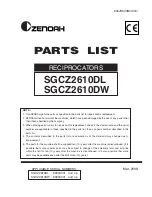
13 ENGLISH
Press cutting
►
Fig.27:
1.
Vertical vise
Secure the workpiece with the vise. Switch on the tool
without the blade making any contact and wait until the
blade attains full speed before lowering. Then gently
lower the handle to the fully lowered position to cut the
workpiece. When the cut is completed, switch off the
tool and WAIT UNTIL THE BLADE HAS COME TO A
COMPLETE STOP before returning the blade to its fully
elevated position.
Miter cutting
Refer to the previously covered "Adjusting the miter
angle".
Bevel cut
►
Fig.28
Loosen the knob and tilt the saw blade to set the bevel
angle (Refer to the previously covered "Adjusting the
bevel angle"). Be sure to retighten the knob firmly to
secure the selected bevel angle safely. Secure the
workpiece with a vise. Switch on the tool without the
blade making any contact and wait until the blade
attains full speed. Then gently lower the handle to the
fully lowered position while applying pressure in parallel
with the blade. When the cut is completed, switch off the
tool and WAIT UNTIL THE BLADE HAS COME TO A
COMPLETE STOP before returning the blade to its fully
elevated position.
CAUTION:
Always be sure that the blade will
move down to bevel direction during a bevel cut.
Keep hands out of path of saw blade.
CAUTION:
During a bevel cut, it may create
a condition whereby the piece cut off will come
to rest against the side of the blade.
If the blade is
raised while the blade is still rotating, this piece may
be caught by the blade, causing fragments to be scat-
tered which is dangerous. The blade should be raised
ONLY after the blade has come to a complete stop.
CAUTION:
When pressing the handle down,
apply pressure parallel to the blade.
If the pressure
is not parallel to the blade during a cut, the angle of
the blade might be shifted and the precision of the cut
will be impaired.
CAUTION:
(Only for tools with sub-fence)
Always set the sub-fence outside when perform-
ing left bevel cuts.
Compound cutting
Compound cutting is the process in which a bevel
angle is made at the same time in which a miter angle
is being cut on a workpiece. Compound cutting can be
performed at the angle shown in the table.
Bevel angle
Miter angle
45°
Left and Right 0° - 45°
When performing compound cutting, refer to “Press
cutting”, “Miter cutting” and “Bevel cut” explanations.
Cutting crown and cove moldings
Crown and cove moldings can be cut on a compound
miter saw with the moldings laid flat on the turn base.
There are two common types of crown moldings and
one type of cove moldings; 52/38° wall angle crown
molding, 45° wall angle crown molding and 45° wall
angle cove molding.
►
Fig.29:
1.
52/38° type crown molding
2.
45° type
crown molding
3.
45° type cove molding
There are crown and cove molding joints which are
made to fit "Inside" 90° corners ((a) and (b) in the figure)
and "Outside" 90° corners ((c) and (d) in the figure.)
►
Fig.30:
1.
Inside corner
2.
Outside corner
►
Fig.31:
1.
Inside corner
2.
Outside corner
Measuring
Measure the wall width, and adjust the width of the
workpiece according to it. Always make sure that width
of the workpiece's wall contact edge is the same as wall
length.
►
Fig.32:
1.
Workpiece
2.
Wall width
3.
Width of the
workpiece
4.
Wall contact edge
Always use several pieces for test cuts to check the
saw angles.
When cutting crown and cove moldings, set the bevel
angle and miter angle as indicated in the table (A) and
position the moldings on the top surface of the saw
base as indicated in the table (B).
In the case of left bevel cut
►
Fig.33:
1.
Inside corner
2.
Outside corner
Table (A)
–
Molding
position
in the
figure
Bevel angle
Miter angle
52/38°
type
45° type
52/38°
type
45° type
For
inside
corner
(a)
Left
33.9°
Left 30°
Right
31.6°
Right
35.3°
(b)
Left
31.6°
Left
35.3°
For
outside
corner
(c)
(d)
Right
31.6°
Right
35.3°
Table (B)
–
Molding
position in
the figure
Molding
edge against
guide fence
Finished
piece
For inside
corner
(a)
Ceiling
contact
edge should
be against
gxuide fence.
Finished
piece will be
on the Left
side of blade.
(b)
Wall contact
edge should
be against
guide fence.
For outside
corner
(c)
Finished
piece will be
on the Right
side of blade.
(d)
Ceiling
contact edge
should be
against guide
fence.
Summary of Contents for M2300
Page 2: ...1 Fig 1 1 Fig 2 1 2 3 Fig 3 1 Fig 4 1 Fig 5 1 Fig 6 1 Fig 7 1 Fig 8 2 ...
Page 3: ...1 Fig 9 2 1 3 130mm Fig 10 1 2 Fig 11 1 Fig 12 1 Fig 13 1 2 Fig 14 1 Fig 15 1 2 Fig 16 3 ...
Page 4: ...1 Fig 17 1 2 Fig 18 1 2 3 4 Fig 19 1 2 3 4 5 6 Fig 20 1 Fig 21 1 Fig 22 1 Fig 23 1 2 Fig 24 4 ...
Page 7: ...1 Fig 41 1 2 3 Fig 42 1 Fig 43 1 2 Fig 44 Fig 45 1 2 Fig 46 7 ...
Page 95: ...95 ...














































